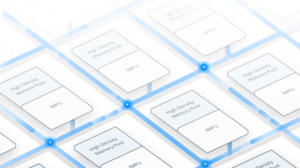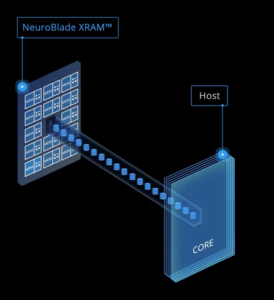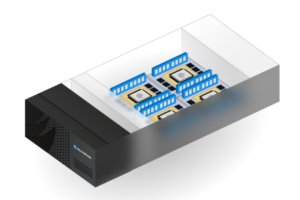
NeuroBlade Tackles Memory, Bandwidth Bottlenecks with XRAM

Neuroblade tackles the I/O bottleneck by placing RISC processing power right on the DRAM
Companies that are frustrated by the performance of memory- or network-bound analytics workloads may be interested in learning about NeuroBlade, a hardware startup developing a new processing-in-memory (PIM) architecture called XRAM that features a RISC processor fused to the DRAM itself.
According to NeuroBlade co-founder and CEO Elad Sity, NeuroBlade has redesigned the memory architecture itself in a way that allows the insertion of small, programmable processing cores that are closely coupled to DRAM.
“The cores that are built within the NeuroBlade XRAM memory are non-standard RISC processors designed by NeuroBlade itself,” Sity tells Datanami via email. “NeuroBlade’s [software] stack and SDK [software development kit] hide the complexity and programming model for these cores from the end user and also optimize multiple kernels for maximum parallelism and efficiency.”
NeuroBlade also created a server appliance, or what it calls an Intense Memory Processing Unit (IMPU), called the Xiphos that features these XRAM memories. The Xiphos can be connected to a standard host within the data center, Sity says, and comes with all the software needed to speed up data analytics workloads.
With XRAM and Xiphos, NeuroBlade is targeting data intensive workloads that are limited by the amount of memory or I/O that is available, as opposed to compute-bounded workloads, which CPUs and GPUs are a good fit for, Sity says. The company says its approach can potentially increase the speed for analytics by 100x.
“Data analytics, or more specifically SQL workloads, are NeuroBlade’s first target, though soon other data intensive workloads will follow,” Sity says. “In a classic system, the CPU and the memory are separated from each other, and therefore when data has to be processed it has to be moved from the memory to the CPU. In data intensive applications, which is our focus, the processing of the data is fairly quick and hence the bottleneck for overall fast processing, is not the power of the CPU but rather the speed in which the data is transferred between the memory and the CPU.”
NeuroBlade isn’t the first company to take the PIM approach, but it claims that it’s the first company to actually bring a PIM solution to production. The company, which was founded in 2018 and has more than 100 employees, says it’s already shipping its data accelerator to customers and partners around the world, and says its gear is seeing SQL action with companies in the healthcare, pharmaceutical, finance, advertising, and cybersecurity industries.
Last week, the company announced an $83-million Series B round, bringing the total of outside investment to $110 million. The round was led by Corner Ventures with contribution from Intel Capital, and supported by current investors StageOne Ventures, Grove Ventures and Marius Nacht. MediaTek, Pegatron, PSMC, UMC and Marubeni also provided funding during this round.
Lance Weaver, Intel’s vice president and general manager of its data center and cloud strategy, said the company was proud to invest in NeuroBlade and its technology. “Despite being tested like never before this past year, the data center kept the world operating at a critical time” Weaver stated in a press release. “We think that this market is poised for explosive growth and NeuroBlade looks to have a promising journey ahead.”
Another early NeuroBlade partner is SAP. Patrick Jahnke, head of the innovation office at SAP, says the enterprise software giant is looking forward to working with NeuroBlade to speed database management system (DBMS) workloads.
“The performance projections and breadth of use cases prove great potential for significantly increased performance improvements for DBMS at higher energy efficiency and reduced total-cost of ownership on-premises and in the cloud,” Jahnke stated in a press release. “Through this exciting collaboration with NeuroBlade, SAP will unlock new possibilities to build the data center of the future.”
Related Items:
VMware Seeks to Liberate Memory Bottlenecks with Project Capitola
Filling Persistent Gaps in the ‘Big Memory’ Era
The Past and Future of In-Memory Computing

































